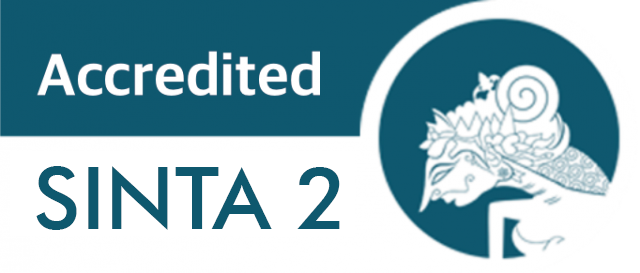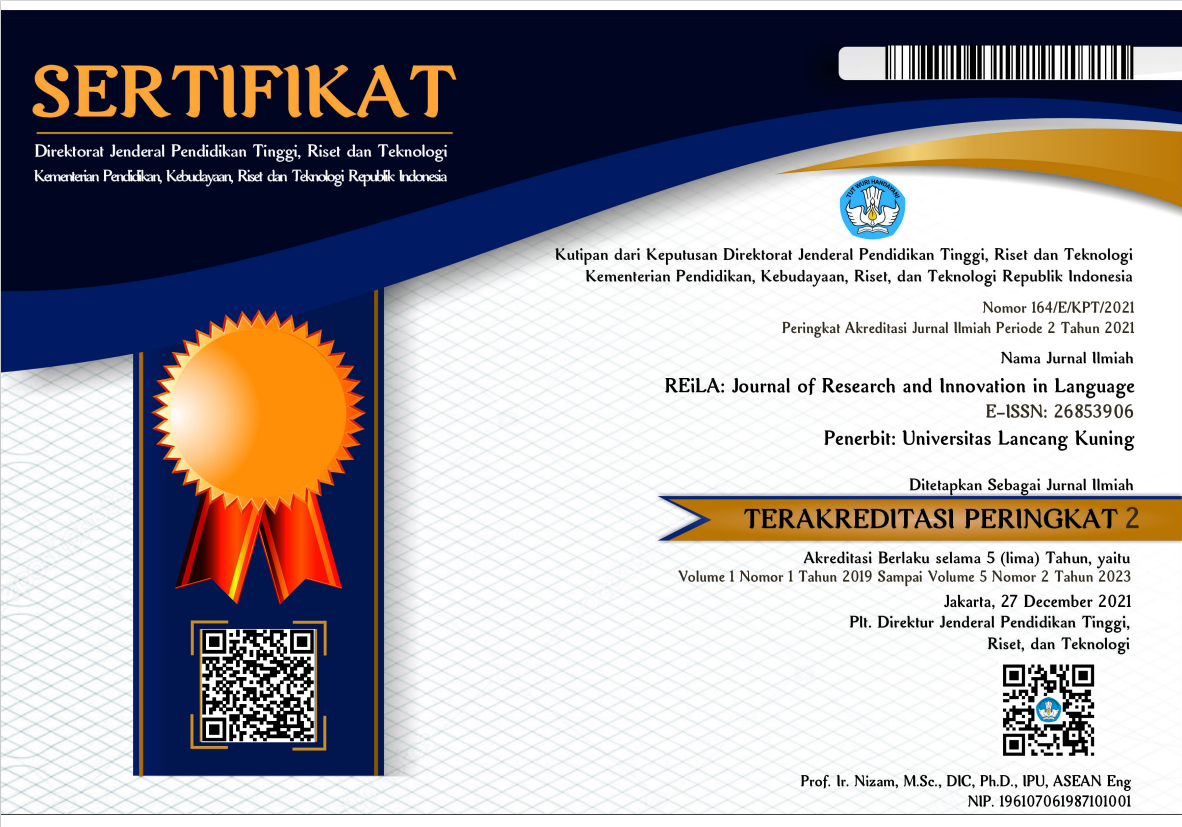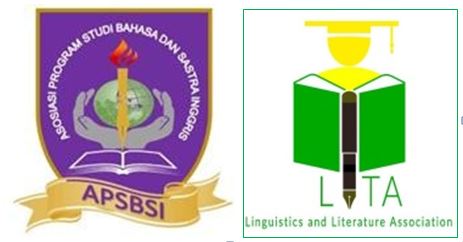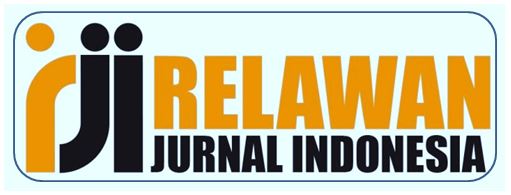The COVID-19 Hoax News in Indonesia Context: Looking Beyond the Essence Using Content Analysis
Abstract
The hoax has been widely discussed in many studies employing various approaches, and one of the hoaxes massively spread recently is news about COVID-19. This qualitative study aims at investigating the essence of hoax news related to COVID-19 in the Indonesian context using a content analysis approach. The main source of data was 50 hoax news collected from turnbackhoax.com, which is one of the credible anti-hoax news sources in Indonesia. The present study collected the news from 1st January 2022 until 30th March 2020. They were then analysed and interpreted qualitatively. The research findings revealed that hoax news circulated during this pandemic era mostly had the purpose of sparking public panic, especially panic buying and panic moving. To trigger such a condition, writers of hoax news frequently used symbols such as time markers (time signals) and quantifiers and involved famous figures. This implies that hoaxes are not only spread during political events or other important occasions but also when most humans in the world experience mass trauma, which in this case is due to the COVID-19 pandemic.
Downloads
References
Allcott, H., & Gentzkow, M. (2017). Social media and fake news in the 2016 election. Journal of economic perspectives, 31(2), 211-36. https://doi.org/10.3386/w23089
Arif, R. (2016). Internet as a hope or a hoax for emerging democracies: revisiting the concept of citizenship in the digital age. Procedia-Social and Behavioral Sciences, 236, 4-8. https://doi.org/10.1016/j.sbspro.2016.12.002
Assiroj, P., Hidayanto, A. N., Prabowo, H., & Warnars, H. L. H. S. (2018). Hoax news detection on social media: A survey. In 2018 Indonesian Association for Pattern Recognition International Conference (INAPR) (pp. 186-191). IEEE. https://doi.org/10.1109/inapr.2018.8627053
Astrika, L., & Yuwanto, Y. (2019). Ujaran kebencian dan hoaks: signifikasinya terhadap pemilih pemula di Kota Semarang. JIIP: Jurnal Ilmiah Ilmu Pemerintahan, 4(2), 107-118. https://doi.org/10.14710/jiip.v4i2.5433
Bratich, J. (2020). Civil society must be defended: Misinformation, moral panics, and wars of restoration. Communication, Culture, and Critique, 13(3), 311-332. https://doi.org/10.1093/ccc/tcz041
Chong, D. JN Druckman. 2007. Framing theory. Annual Review of Political Science, 101(4), 103-26. https://doi.org/10.1146/annurev.polisci.10.072805.103054
Creswell, J. W. (2012). Educational research Planning, conducting, and evaluating quantitative and qualitative research (4th ed.). MA Pearson.
Chua, A. Y., Cheah, S. M., Goh, D. H. L., & Lim, E. P. (2016). Collective rumor correction on the death hoax of a political figure in social media. Pacific Asia Conference on Information Systems. https://ink.library.smu.edu.sg/sis_research/3609/
Dan, V., Paris, B., Donovan, J., Hameleers, M., Roozenbeek, J., van der Linden, S., & von Sikorski, C. (2021). Visual mis-and disinformation, social media, and democracy. Journalism & Mass Communication Quarterly, 98(3), 641-664. https://doi.org/10.1177/10776990211035395
Dharmastuti, A., Apriliyanti, F., & Wahyuni, F. (2020). Exploring the Impact of COVID-19 Hoax on the Mental Health of Millennial Moms. KnE Social Sciences, 408-429.
Epafras, L. C., Djalong, F. A., & Kaunang, H. P. (2018). Beyond signal and noise: Academics goes hoax and hoaxtivism. Jurnal Kawistara, 8(3), 247-261. https://doi.org/10.22146/kawistara.34646
Ginting, J. A., Manongga, D., & Sembiring, I. (2018, November). The spread path of hoax news in social media (facebook) using social network analysis (SNA). In 2018 International Seminar on Research of Information Technology and Intelligent Systems (ISRITI) (pp. 405-409). IEEE. https://doi.org/10.1109/isriti.2018.8864444
Glass, G. V., & Shaughnessy, M. F. (2015). An Interview with Dr. Gene V. Glass about myths and hoaxes in educational psychology. North American Journal of Psychology, 17(2), 311.
Grech, V. (2019). Write a Scientific Paper (WASP): Academic hoax and fraud. Early human development, 129, 87-89. https://doi.org/10.1016/j.earlhumdev.2018.12.005
Halliday, M. A. (1992). Language as system and language as instance: The corpus as a theoretical construct. Directions in corpus linguistics, 61-77. https://doi.org/10.1515/9783110867275.61
Hasfi, N., Santosa, H. P., & Lukmantoro, T. (2017). Primordialism through hoax and fake news during the 2014 presidential election of Indonesia. In ICISPE International Conference.
Ilahi, H. N. (2018). Women and hoax news processing on WhatsApp. Jurnal Ilmu Sosial dan Ilmu Politik, 22(2), 98-111. https://doi.org/10.22146/jsp.31865
Li, X., Zhou, Y., Wong, Y. D., Wang, X., & Yuen, K. F. (2021). What influences panic buying behaviour? A model based on dual-system theory and stimulus-organism-response framework. International Journal of Disaster Risk Reduction, 64, 102484. https://doi.org/10.1016/j.ijdrr.2021.102484
Lyons, John. (1969). Introduction to theoretical linguistics. Great Britain: Cambridge University Press. https://doi.org/10.1017/cbo9781139165570.002
Marbella, H. N., Nur’aini, N. H., Agung, S., & Rakhmawati, N. A. (2021). Analisis pengaruh berita bohong di sosial media terhadap keputusan masyarakat Indonesia melakukan vaksinasi covid-19. Jurnal Indonesia Sosial Teknologi, 2(11), 1951-1966. https://doi.org/10.36418/jist.v2i11.267
Marbun, R. (2020, March). Disengagement of hoax and hate speech from social context: Analysis of intersection between criminal law and the influence of the linguistic. In International Conference on Law Reform (INCLAR 2019) (pp. 147-151). Atlantis Press. https://doi.org/10.2991/aebmr.k.200226.030
Martínková, L. (2008). Unsolicited Religious E-mail, Researching New Context of Religious Communication. Masaryk University Journal of Law and Technology, 2(2), 113-126.
Mofakhami, A. (2021). The effect of moral competence on online conformity behavior. Ethics in Progress, 12(1), 73-83. https://doi.org/10.14746/eip.2021.1.6
Mustika, R. (2018). Etika berkomunikasi di media online dalam menangkal Hoax. Diakom: Jurnal Media dan Komunikasi, 1(2), 43-50. https://doi.org/10.17933/diakom.v1i2.30
Panizza, F., Vostroknutov, A., & Coricelli, G. (2021). How conformity can lead to polarised social behaviour. PLoS Computational Biology, 17(10), e1009530. https://doi.org/10.31234/osf.io/q4n35
Park, K., & Rim, H. (2019). Social media hoaxes, political ideology, and the role of issue confidence. Telematics and Informatics, 36, 1-11. https://doi.org/10.1016/j.tele.2018.11.001
Pérez, Sabater, C. (2012). The linguistics of social networking: A study of writing conventions on facebook. Linguistik online, 56(6), 81-93. https://doi.org/10.13092/lo.56.257
Prasetijo, A. B., Isnanto, R. R., Eridani, D., Soetrisno, Y. A. A., Arfan, M., & Sofwan, A. (2017, October). Hoax detection system on Indonesian news sites based on text classification using SVM and SGD. In 2017 4th International Conference on Information Technology, Computer, and Electrical Engineering (ICITACEE) (pp. 45-49). IEEE. https://doi.org/10.1109/icitacee.2017.8257673
Putri, T. T., Sitepu, I. Y., Sihombing, M., & Silvi, S. (2019). Analysis and detection of hoax contents in indonesian news based on machine learning. Journal of Informatic Pelita Nusantara, 4(1). 19-26 https://doi.org/10.30534/ijatcse/2020/297942020
Rahayu, W. H., Utari, P., & Wijaya, M. (2019). The motivation of hoax message recipients in the process of disseminating hoax information on facebook group. International Journal of Multicultural and Multireligious Understanding, 6(4), 414-421. https://doi.org/10.18415/ijmmu.v6i4.1015
Ravitch, D. (2014). Hoaxes in educational policy. The Teacher Educator, 49(3), 153-165. https://doi.org/10.1080/08878730.2014.916959
Salam, A. (2018). The Hoax phenomenon in indonesian society: Observing anti-diversity memes since 2014. Humaniora, 30(3), 315-324. https://doi.org/10.22146/jh.v30i3.38891
Santoso, I., Yohansen, I., Warnars, H. L. H. S., & Hashimoto, K. (2017, November). Early investigation of proposed hoax detection for decreasing hoax in social media. In 2017 IEEE International Conference on Cybernetics and Computational Intelligence (CyberneticsCom) (pp. 175-179). IEEE. https://doi.org/10.1109/cyberneticscom.2017.8311705
Scott, M. (2020). Social media giants are fighting coronavirus fake news. It’s still spreading like wildfire. Politico. https://www. politico. com/news/2020/03/12/social-media-giants-are-fighting-coronavirus-fake-news-its-still-spreading-like-wildfire-127038.
Shiddiq, S. (2020). Pengaruh media sosial facebook dalam penyebaran hoax dan dampaknya terhadap kecemasan masyarakat (studi terhadap masyarakat di kota Yogyakarta) [Doctoral dissertation, Universitas Mercu Buana Yogyakarta]. UMBY Repository. http://eprints.mercubuana-yogya.ac.id/9039/
Suyanto, T., Zen, I. M., Prasetyo, K., Isbandono, P., Gamaputra, G., & Purba, I. P. (2018, January). The study perception of social sciences and law faculty students for hoax in social media. In Journal of Physics: Conference Series (Vol. 953, No. 1, p. 012151). IOP Publishing. https://doi.org/10.1088/1742-6596/953/1/012151
Tanase, L. M., Kerr, J., Freeman, A., & Schneider, C. (2021). The effects of President Trump’s COVID-19 diagnosis on hoax beliefs and risk perceptions of the virus in the US (preprint). https://doi.org/10.31234/osf.io/frxt8
Tulung, J. M., & Kalampung, Y. O. (2019, August). Digital literacy effort by Indonesian churches in the midst of hoax problems. In 1st Annual International Conference on Social Sciences and Humanities (AICOSH 2019). Atlantis Press. https://doi.org/10.2991/aicosh-19.2019.50
Utami, P. (2018). Hoax in modern politics: the meaning of hoax in Indonesian politics and democracy. Jurnal Ilmu Sosial dan Ilmu Politik, 22(2), 85-97. https://doi.org/10.22146/jsp.34614
Volkova, S., Shaffer, K., Jang, J. Y., & Hodas, N. (2017, July). Separating facts from fiction: Linguistic models to classify suspicious and trusted news posts on Twitter. In Proceedings of the 55th Annual Meeting of the Association for Computational Linguistics (Volume 2: Short Papers) (pp. 647-653). https://doi.org/10.18653/v1/p17-2102
Walia, R. (2015). A saga of qualitative research. Social Crimonol, 5(2), 124-127. https://doi.org/10.4172/2375-4435.1000124
Walsh, J. P. (2020). Social media and moral panics: Assessing the effects of technological change on societal reaction. International Journal of Cultural Studies, 23(6), 840-859. https://doi.org/10.1177/1367877920912257
Walsh, L. (2006). The scientific media hoax: A rhetoric for reconciling linguistics and literary criticism. Rhetorical agendas: Political, ethical, spiritual, 165-176. https://doi.org/10.4324/9781410615688-26
Wimmer, W. (1998). Religious hoaxes-the miracles of weeping and bleeding in criminology. KRIMINALISTIK, 52(3), 195-198.
Yunus, N. R., & Rezki, A. (2020). Kebijakan pemberlakuan lock down sebagai antisipasi penyebaran corona virus Covid-19. Salam: Jurnal Sosial dan Budaya Syar-i, 7(3), 227-238. https://doi.org/10.15408/sjsbs.v7i3.15083
Zannettou, S., Sirivianos, M., Blackburn, J., & Kourtellis, N. (2019). The web of false information: Rumors, fake news, hoaxes, clickbait, and various other shenanigans. Journal of Data and Information Quality (JDIQ), 11(3), 1-37. https://doi.org/10.1145/3309699
Zheng, G. W., Siddik, A. B., Yan, C., & Masukujjaman, M. (2020). Official and unofficial media information and the public panic during the COVID-19 pandemic in China: An empirical analysis. Rev Argent Clínica Psicológica, 29(5), 1538-1551. https://doi.org/10.24205/03276716.2020.1151










